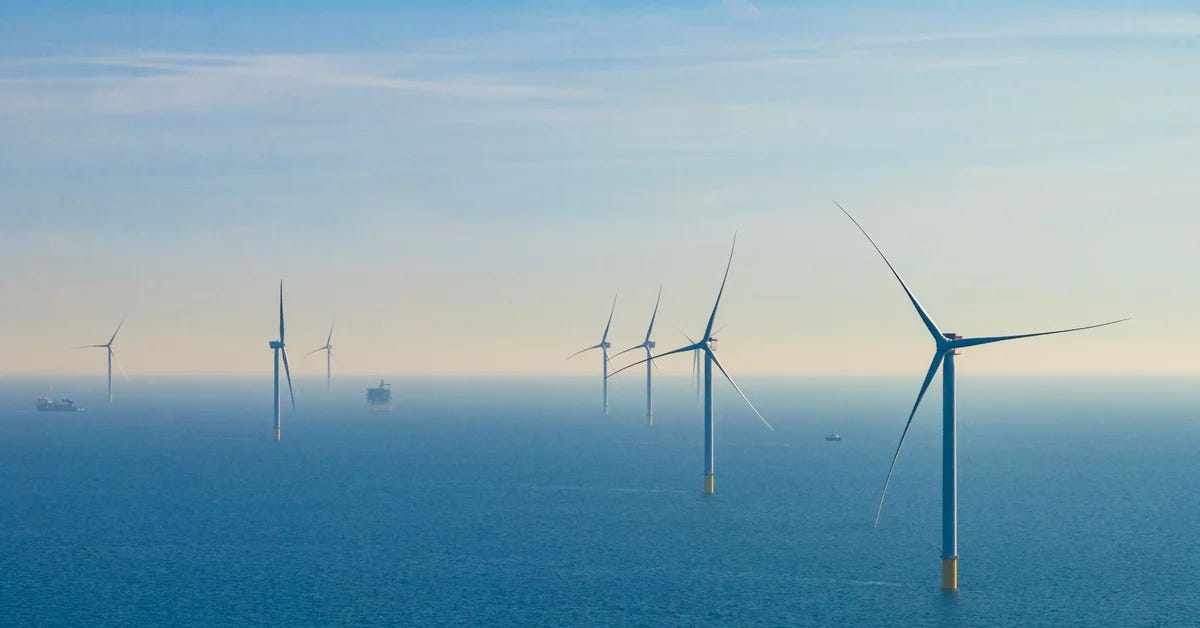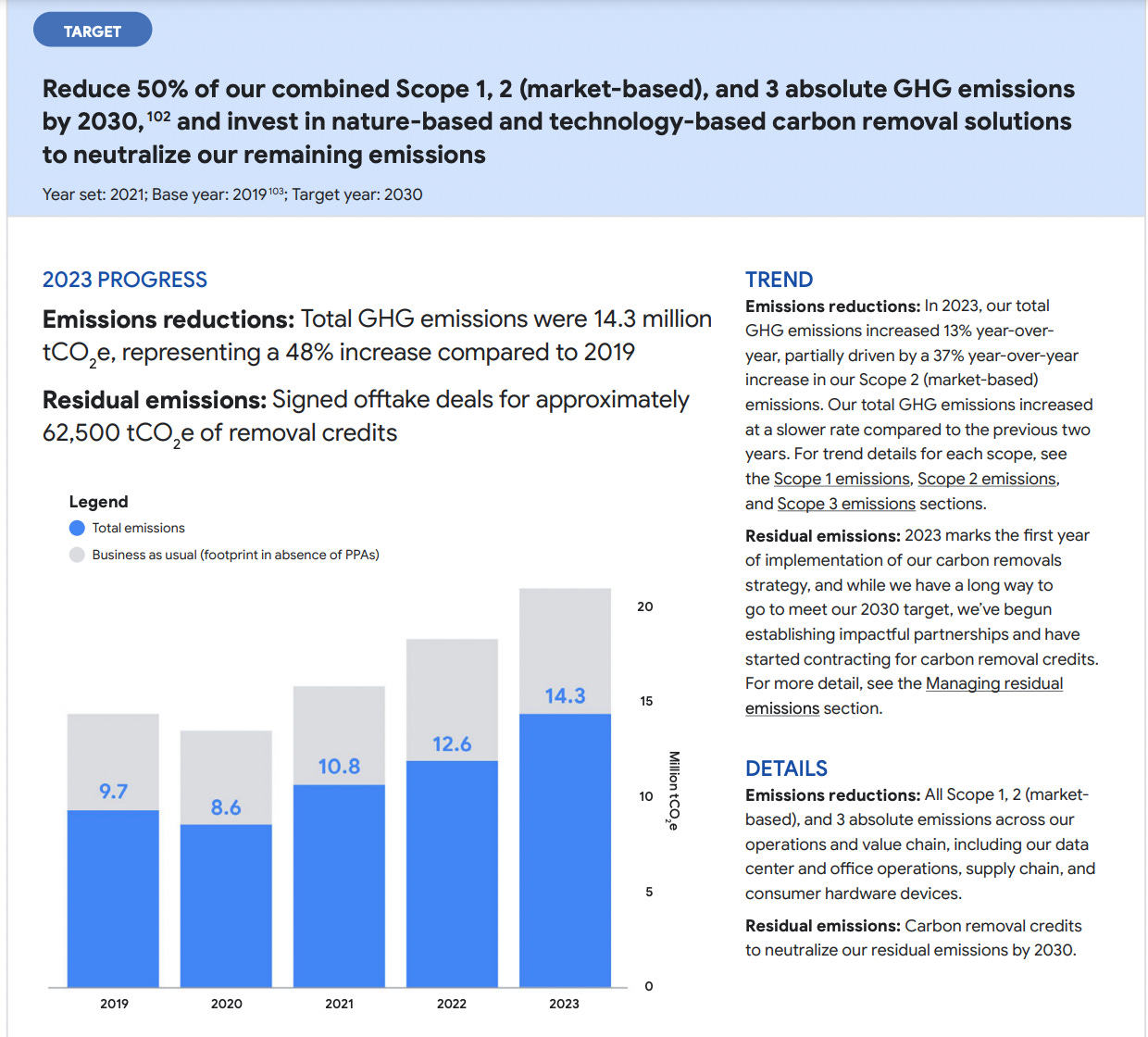ExaminingESG: Google vs. Microsoft
As U.S. policy change to encourage renewable growth is likely stalled, how can some of the largest companies in the world maintain sustainability commitments?
I know that I have been absent for a few months because, typically, I work on this newsletter on Sundays. Over the summer, I purposefully chose to use Sundays for the beach and all of my other free time was spent studying for the Project Management exam and looking for a new job. Luckily, I was successful in hitting all three of those goals.
My tan now faded, I’m now back with a topic I’ve wanted to dedicate time to for a while: Google versus Microsoft.

As massive, globally used and recognized technology companies with over a combined 300,000 employees, the scale and influence they have to drive ESG and sustainability action is unmatched. They have each committed to Net Zero goals, biodiversity, and water replenishing intents, and Alphabet — Google’s parent company — is a founding funder of Frontier.
Frontier intends to create demand for carbon removal technologies to help drive innovation in the field, especially solutions that are scalable and permanent, and the hope is that with large companies like Google highlighting their commitment to purchasing carbon removal, a larger market will be created.
What do Google and Microsoft do, and why does it require so much energy?
It’s hard to highlight what each company does; they seem to do everything. You can find ExaminingESG via Google, and you likely used Google Maps for directions this week while also sending messages via Teams to your coworkers. All of those things and more require energy around the clock.
A few key areas of overlap for Google and Microsoft are digital cloud storage, search engines, consumer products, and Artificial Intelligence — all of which require energy and electricity across supply chains in the form of mining metals to build laptops to generate electricity that runs data centers.
Both Google and Microsoft emit millions of tons of emissions every single year and in recognizing their need for continuous power, have developed unique solutions.
Increasing electricity demand subsidized by nuclear
Because of their increased data center buildouts and investments in AI technology, both Google and Microsoft’s greenhouse gas emissions have increased in 2023, even after declining for years. 2023 is before AI was fully embraced, so I am a bit nervous about the 2024 numbers that will come out next year, let’s hope their continued renewable energy embracing keeps emissions low.
Even before AI’s explosive growth, Google has a history of helping to build out their own sources of energy for business use, from geothermal to wind farm plants that are directly linked to their data centers. This ensures their energy source is always available to them and helps increase renewable energy use within their operations.
But one of the issues with most types of renewable energy is that it cannot be relied on 24/7 without battery storage, the sun is not always shining and the wind is not always blowing — enter nuclear. Nuclear energy can be produced 24/7, but as a renewable energy option, it has been controversial for years due to the radioactive wastewater produced and the potential for nuclear accidents.
What is the most challenging for me to reconcile is the fact that as the years pass by, and the emissions reductions of entire countries fail to be met, energy demand continues to increase, and while oftentimes, renewable energy is being used to supply this demand, it’s not taking away from the existing demand that also needs a constant energy supply.
In other words, we are not reducing our energy use at all, just supplying our increasing energy needs with renewable sources.
This shift in utilizing nuclear by tech companies is focusing on small modular reactors, which are cheaper and take less time to build than traditional reactors, but still, they have yet to exist. A lot of Net Zero goals are staked on reactors that are not yet built.
Personally, AI hasn’t replaced anything for me in my life. Maybe I am missing out and should let it write this newsletter for me, but it is increasing in popularity and Google and Microsoft are ready to supply it.
The Google 2024 Environmental Report
Part of Google’s mission is to organize the world’s data and to ensure that data can be shared. Google organizes data in a few ways: by offering cloud storage to companies, being the go-to search engine and “information storer,” and even through technology consumption by selling phones, smartwatches, and the Google Nest thermostat.
In my last job, part of my role was writing solar and renewable energy content that was meant to teach the reader about the topic, yes, but more importantly to be Search Engine-Optimized and continuously improved and rewritten to chase Google Algorithm updates to make the article move as far up to the top of the page as possible.
I won’t join the debate on how AI may have made Google’s main product page more confusing, but I can say that Google is extremely ingrained in most people’s lives. As an $88 billion company, Google does recognize its significance in showcasing how a technology company can run sustainably.
In 2021, Google committed to a Net Zero goal by 2030 and was on track to meet this goal until AI exploded in popularity and caused Google’s overall emissions to increase by 13% in 2023.

Google does recognize this issue upfront by noting “When technological advancement is converging with the need for energy transition….” and very clearly showcases their rise in emissions. But they are also hoping they can “harness AI to drive environmental change,” which sounds slightly like kicking the can down the road.
To help mitigate this upward swing in emissions, Google highlights many additional sustainable-focused commitments within its 86-page report.
Here are the projects that stood out to me:
Google has pointed to their consumer products as a way to reach their goal of “reducing 1 gigaton of carbon equivalent emissions by 2030…” especially things like the Google Nest, helping homeowners reduce energy use, and utilizing AI to determine more carbon friendly routes via Google Maps or Project Green Light.
The reduction of 1 gigaton is meant to broaden emissions reduction options for consumers and external businesses.
Some of Google’s technology can be used by companies and scientists for mitigation and adaption efforts, via flood prediction technology and satellites that track climate variables from rainfall patterns to methane emissions - satellites I’ve used for the project I talk about here.
In the spirit of sharing their knowledge, Google recently released an open-source guide to circular packaging, meaning packaging that can either be fully recycled or composted, for other companies to learn from and emulate.
Google has a 4-point approach to addressing sustainability within its operations:
Accelerating the transition to net zero: Projects that fall under this are things like adding nuclear power and purchasing carbon offsets for emissions that can’t be completely generated from renewable sources.
Advancing water stewardship: This ranges from utilizing wastewater for cooling at data centers to reducing water use at global offices.
Advocating for the circular economy: Like the example I shared above, Google is helping to advance sustainable packaging options.
Restore and advance biodiversity: Many of these projects occur at Google campuses, like planting native trees and creating pollinator habitats.
Google validates its Net Zero goals against Science Based Target Initiatives and reports its data to SASB and TCFD.
What I did not like:
The acknowledgment that policy reform is a missing link to sweeping environmental change. While true, and Google is attending COP29 to advocate for this, it seems more like laying the blame on others as one of the largest, richest companies in the world.
With the new U.S. presidential administration, policy change is even less likely to occur even if sustainability is a winning business strategy. This means companies have more of an imperative to step up and be the change needed.
The Microsoft 2024 Environmental Sustainability Report

Microsoft, like Google, is one of the largest technology companies in the world and does arguably the same thing, with a much less reverent following — I’ve never had to write an article optimized to Bing’s search algorithm. No offense to Microsoft.
Microsoft has committed to be Carbon negative, and water-positive, to produce zero waste and protect more land than they use by 2030.
Like Google, Microsoft’s emissions increased in 2023, specifically their Scope 3 emissions, even as their Scope 1 & 2 emissions decreased. This increase was due to data centers that provide cloud storage and likely AI use.
Here’s what stood out:
Microsoft highlights a new way for AI use - to detect water leakage across their operations like reducing water for cooling at data centers, and Microsoft is looking to use water more efficiently.
Partnerships with the Nature Conservancy and the National Fish and Wildlife Foundation to acquire and protect land is great because this gives Microsoft third-party assurance that lands are protected, and it also goes beyond just ensuring land their buildings are on is conserved.
Microsoft has a software, Microsoft Sustainability Manager, that helps companies track their Scope 1,2, and 3 emissions. Microsoft is using its size and scale to provide capabilities for others to track and meet their sustainability goals.
What was not great:
Microsoft currently does not hold its reporting standards against any ESG industry metrics such as SASB or SBTi reporting. But, Microsoft is audited by Deloitte, which offers an important step for verifying the data.
Google, Microsoft and Frontier
When Net Zero goals started to become popular, larger companies always knew there would be emissions that they could not get rid of completely, whether it was Scope 3 emissions that external companies could not reduce, or that there would always be continued increasing electricity demand from things like AI.
Emissions that are impossible, or are extremely challenging to reduce, are sidelined to being either offset or removed. The issue with carbon removal though is that technologies do exist, but not at a scale necessary to make a meaningful impact.
This is where Frontier comes in.
Frontier exists to showcase that there is a market for carbon removal, with the intention that start-ups would commit to developing scalable tools for removal by ensuring companies like Google would pay for the end product.
So far, the new solutions seem to be relying on technologies that already exist like storing carbon-rich waste underground. But, this is a good example of how companies can encourage industry change even without policy upgrades.
The challenge of AI, the U.S. election, and ESG reporting.
As mentioned, as the world builds out more renewable energy, we are not reducing, or even maintaining our electricity consumption. Building renewable energy for personal company use is better than companies continuing to rely on fossil fuels, but we need to reduce emissions, not increase them while lessening their impact by using renewable energy.
While sustainability practices do ultimately save money and help companies prepare for and manage against ever-increasing climate disasters, the U.S. election can be used as an excuse for some companies to eliminate their sustainability goals since likely renewable energy and ESG metrics will take a backseat as pollution standards are rolled back and fossil fuels are being embraced.
For now, I’ll be grasping at Elon Musk’s potential influence to encourage EV and renewable growth and that the Inflation Reduction Act’s proven track of increasing American factory build-outs and jobs allows it to remain.
I do suspect that ESG reporting won’t be as important going forward because, in the U.S., it is not yet legally binding and was embraced as the cultural winds favored sustainable business practices in theory.
Unfortunately, the American people might have just shown that sustainability is not valued and companies might begin to stop mentioning sustainability at all.
I hope none of that is true.
There are so many more topics I can dig into, and I need to read more deeply about Microsoft. I want to review more of each company’s practices like PPA purchases, biodiversity commitments, and how Google is focusing on reducing the Scope 3 emissions of its users. So I am curious, would another Google and Microsoft newsletter next month be boring?
Let me know.

